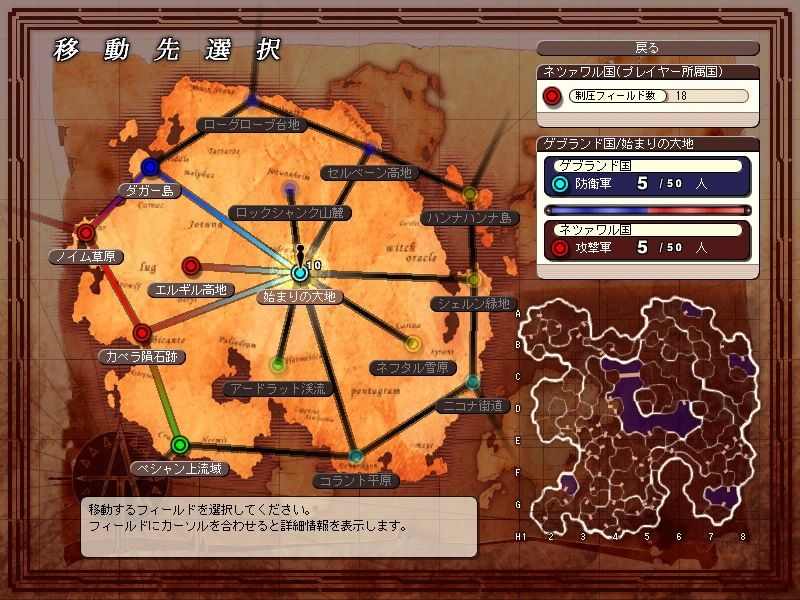
The overall theme of the gameplay was emulating the entertainment of both player battles and normal player-versus-environment combat. By this point, Tetsuya Fujimoto acted as the game's director, while Akashi Yamaguchi was lead designer. Kamitani and Puraguru left production in 2004, and development was taken over by Multiterm. By 2003, Enix had merged with Square to become Square Enix, and Kamitani stated that the newly-merged company took the project away from him. Production was originally placed in a small section of the Enix company building nicknamed the "submarine". It was Kamitani's first time developing a 3D game, and he recycled artwork and assets from Dragon's Crown, a cancelled Dreamcast sequel to Princess Crown. The project was originally planned as a battle scenario between humans and vampires, but under Kamitani's guidance the scenario changed to a battle between princess-themed kingdoms. The project ballooned in scale, and to facilitate its development Kamitani created a small development studio dubbed Puraguru (later known as Vanillaware) in 2002. During this period, it was headed by George Kamitani, a developer whose previous work included fighting games for Capcom and the Sega Saturn game Princess Crown. įantasy Earth Zero began production in 2001 as Fantasy Earth: The Ring of Dominion, a small-scale online game project led by Enix. In-game items could be earned, or bought for real money at a dedicated shop. Later updates added new building types, weather effects, and additional levels of factions for players to interact with. During battles, players could also use special structures to summon allied monsters into the battlefield, granting advantages in battles. Players could use resources taken from crystals scattered across the battle map and construct different types of fortification and buildings, ranging from defensive structures to buildings which offered player advantages or could be used to directly attack the enemy. Īnother element of these battles was a building and fortification aspect similar to tower defense games. Experience points were distributed across the victorious player army based on overall performance. Victory for either side was determined by territory controlled and individual enemy players defeated.
FANTASY EARTH ZERO JAPAN FREE
During battles, players needed to manually aim attacks at their opponent, and were allowed free movement through the map. Kingdom-versus-kingdom battles were all held on the same server. A maximum of fifty players were allowed on each sides of the battle. Players from the two warring kingdoms received preference in this queue. Player-versus-player battles were balanced by forcing each side to have a similar number of participants, placing "overflow" players into a queue waiting to enter the battle.


Alongside this, there was a player versus environment element, with players able to fight hoards of monsters for lower rewards. The main emphasis of gameplay was player-versus-player battles, carried out on the same server starting with a minimum of seven versus seven, it went up to large-scale battles between two armies of fifty players. During the character creation stage, the player chose a gender, character class, weapon type and starting nation. In the game's setting of Melpharia, a long era of peace causes ancient petty differences between the nations to erupt into full-scale wars for control over magical crystals that gave birth to all things. There was no storyline beyond the setting and premise, with the intended narrative being created by the battles of player factions. Kamitani and Basiscape would collaborate on all future Vanillaware titles.Ī large-scale battles between player factionsįantasy Earth Zero was a massively multiplayer online role-playing game (MMORPG) in which the player controls a customizable avatar and chooses one of the five nations to ally with and fight for. Over the years, Fantasy Earth featured collaborations with several other video game series, and spawned two spin-off mobile titles. Reviews have praised its aesthetic and gameplay loop. The original release was unsuccessful, but following its re-release under Gamepot it became successful and profitable, gaining one million players by 2011. The original music was composed by Basiscape, a company founded by composer Hitoshi Sakimoto.

Production met with several challenges including logistic issues, the technology required for large-scape online battles, and the merger of Enix with Square in 2003. Kamitani and Puraguru left the project in 2004 due to differences with Square Enix, with Multiterm taking over production duties. Fantasy Earth began in 2001 as a project under Enix, with Puraguru founder George Kamitani steering the project away from its initial concept of humans fighting vampires to its current kingdom-based aesthetic.


 0 kommentar(er)
0 kommentar(er)
